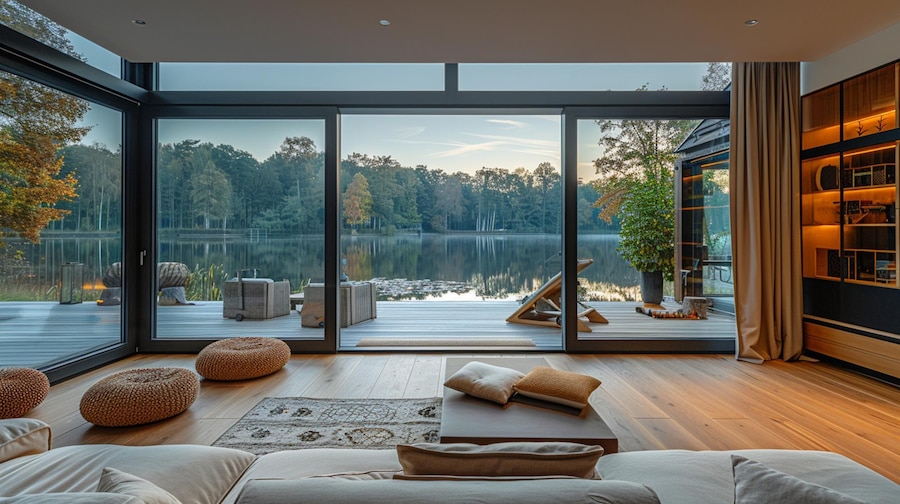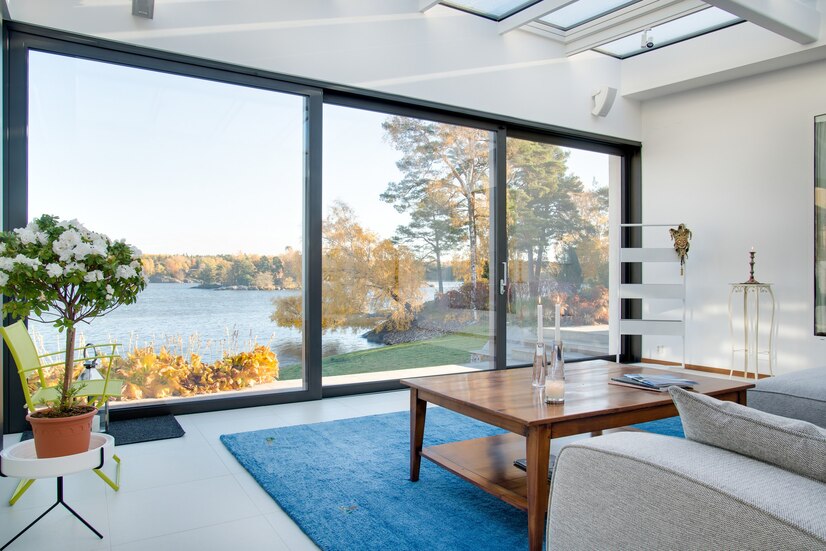Have you noticed any changes in recent years in construction materials such as in doors and windows? In recent years, the construction industry seems to be going through an oceanic change because of the increasing use of eco-friendly materials in doors and windows. Aluminium has gained wide superiority due to its lightweight qualities and durability. This is a 100% recyclable material and can be reused multiple times. To know more about the sustainability of aluminium doors and windows, read onwards.
The Environmental Impacts of Aluminium Production
The aluminium production process requires extensive energy making it a complicated choice for the builders. Aluminum sourcing leads to higher carbon emissions because it needs to be extracted from bauxite ore using high-voltage electricity. Hence, aluminium production has had a negative impact on the environment. The usage of aluminium in windows and doors has become commonplace and this has been used widely in the world in current times.
The Aluminium refining process releases greenhouse gases into the environment leading to global warming. Moreover, mining activities can lead to the destruction of habitats and soil destruction. The whole ecosystem could be impacted due to such activity in refining and melting the aluminium for extensive usage.
Though there are challenges, the current advancement in technology has reduced carbon emissions during the aluminium production process. Manufacturers use hydroelectric power and other sustainable energy solutions to lessen the impacts of the emission.
Additionally, the transition to using refined aluminium has increased extensively instead of just using raw materials from the mine. When the material is recycled, its energy consumption gets reduced making it a more impeccable option for usage. The industry is now paying more attention to the recycled materials over the raw ones.
Recyclability and Circular Economy
The excellent recyclability feature of aluminium means it can be recycled infinitely without any loss in properties. Used aluminium doors and windows can therefore be melted and turned into another new product; they will no longer be in waste, nor waste natural resources.
The recycling process requires only 5% of energy consumption during primary production. Aluminium Systems Companies can think of alternative options by adding refined aluminium to their manufacturing process to make it more sustainable and environmentally friendly.
Aluminium production contributes to circular money by collecting and sorting aluminium cans. Through the recycling process, the primary extraction of aluminium has been reduced. Thus, the environmental impacts have been reduced.
Energy Efficiency and Carbon Footprint Reduction
Aluminium doors and windows help in creating energy efficiency within buildings. These have a good strength-to-weight ratio, hence allowing the designing of slim frame structures that would support large panels of glass while maximizing natural daylight and minimizing the use of artificial lighting. With modern aluminium window system frame designs, having thermal breaks along with insulating properties, a building’s efficiency in terms of heat transfer cannot be ignored as it reduces its dependence on heating and cooling. This further saves carbon emissions in the long term.
Longevity and Low Maintenance
Sustainability in construction does not depend solely on the materials but its lifespan. Aluminium door systems are immune to corrosion, warping, and destruction which makes them a sustainable option as compared to wood and PVC. Aluminium doors and windows are low-maintenance; so, they require fewer resources to be used. This supports the resource conservation process eventually.
Aluminium doors and windows require minimal cleaning and painting making it a reasonable option for lower upkeep. The cleaning process requires simple detergent to keep them in perfect condition. By opting for these doors and windows, homeowners can enjoy the lower maintenance and can save their money and environmental impacts. The sustainability of aluminium doors and windows depends on many associated factors.
Sustainable Manufacturing Practices
Numerous aluminum producers are gradually moving towards supportable practices. These practices comprise such as reducing waste, minimal water usage, and using renewable energy sources in production. Sustainable certifications like Leadership in Energy and Environmental Design and ISO 14001 are mandatory for manufacturers to be registered suppliers. People ought to purchase their items from the guaranteed producers lined up with sustainable practices.
Sustainable Development Goals for Aluminium
SDG 7 promotes clean and affordable energy increasing efficiency through lowering energy consumption. SDG 12 is for promoting responsible consumption and production. Finally, SDG 13 is for energy-efficient designs that would mitigate the impacts of climate change. SGD 7, SDG 12, and SDG 13 are set forth by the United Nations Sustainable Development Goals.
Conclusion
The transition towards environment-friendly construction materials is important for building safe and sound sustainable practices. By giving enough priority to the sustainability of aluminium doors and windows, consumers and manufacturers can take part in developing a safe and greener future. Choose sustainable construction materials for a better future!
Read more: Choose Affordable Aluminium Door Systems with Premium Quality
The world will turn to more environment-friendly approaches. It demands sustainable building materials to rise in the world. This trend is also seen in the Architecture industry. Builders, contractors, Architects, and developers are following sustainable practices, use Aluminium Doors and Windows Systems, and reduce environment impact, and give long terms savings solutions to property owners.
One famous material that stands out is aluminum. Aluminum is used widely for doors and window systems in homes. It plays great importance in sustainable architecture. If you want to look at the Importance of Aluminium Systems and know how they contribute to a greener environment, then here is a blog for you.
Aluminum Systems: The Sustainable Architectural Solutions
Aluminum doors and windows are energy-efficient systems. It means they contribute to reduce the energy amount used in homes, offices and commercial spaces. The Aluminium Systems for Sustainable Architecture are excellent insulation properties, that keep temperature consistent and prevent heat to escape during winter. It also helps to block heat from entering in summer. It reduces energy consumption and also reduces the need for costly cooling and heating systems.
Moreover, the frames of Aluminum are thinner than other materials. This property allows the larger glass panes to be used. It enhances natural light to enter in space, and reduce need of artificial light in day. It reduces energy usage. By choose Aluminum systems, you can reduce energy bills, and carbon footprint. Using Aluminum doors and windows also contributes to sustainable architectural world.
Benefits of Aluminium Doors and Windows
Aluminium systems are the famous choice for sustainable architectural practices, because of various reasons. Let us look at the given benefits to understand the Importance of Aluminium Systems.
Aluminum is Lightweight
The most desirable feature of aluminum is that it is lightweight. By using aluminum in doors and windows, few materials support the load, and reduce material costs, without compromise quality and robustness. This feature make this best material for streamline installation process, and reduce resource usage.
In terms of sustainability, the lightweight feature of Aluminium contributes to less fuel resource usage and reduces carbon emissions. It also demands less energy for cooling, heating, and controls over climate.
Energy Efficiency
Another benefit of using Aluminium Systems for Sustainable Architecture is energy efficiency. The Aluminium doors and windows are well designed with the latest technology and enhance insulation properties. For example, Aluminium doors are easily fitted with double glazing and thermal breaks, and prevent heat loss in winter. It also reduces heat gains in summer. These energy-efficient features reduce energy bills and carbon footprint. It makes these materials important for sustainable architecture.
Recycling
The Aluminium is 100 % recyclable material, and give you benefits by reducing environmental impact. This feature conserves natural resources and saves energy. It save energy by reduce need to use new Aluminium everytime. So, reusing and recycling of Aluminium reduces the environmental footprint and makes a greener environment.
Adaptability to Climate Variability
Buildings are required to withstand extreme temperatures and weather conditions, especially during climate changes. So, the Aluminium Doors and Windows Systems give the inherent resilience to environmental stressors such as heavy rainfall, high winds, and temperature extremes. Their stability and structural integrity make it well suitable for climate-resilient building designs that focus on occupant comfort and safety.
Low Maintenance
The Aluminium Systems for Sustainable Architecture are highly reliable and durable materials that require less maintenance. It enhances the sustainability credentials. As we know, the traditional building materials such as steel or wood requires extensive painting, but Aluminium do not require extensive painting.
Aluminum systems do not require frequent maintenance and keep their top performance. It reduces the use of harmful chemicals and extends its lifespan. It controls over consumption of resources over time.
Improve Indoor Air Quality and Health Benefits
The another benefit of Aluminium Doors and Windows Systems is that it contribute to healthier indoor air. It do not release toxic materials and chemicals in air, and improve indoor air quality. This quality also contributes to sustainable architectural practices.
This is the reason why Aluminium doors and windows are used in sustainable building designs, where the top priority is the safety of occupants. The Aluminium systems are resistant to mildew or mold and thrive easily in humid environments. This resistance improves indoor air quality prevents contaminants and allergens from affects workers health.
Conclusion
Importance of Aluminium Systems do not only aims to reduce environmental impact, but also give you greener solutions for future. Aluminum is a reliable material for buildings and industries because of its energy efficiency and recycling properties.
This material improves recycling rates and optimizes the manufacturing process. It also results in reducing the environmental impact of aluminum. So, Aluminium plays vital role in green buildings, increases in demand, and emerges as key player in sustainable building materials.


